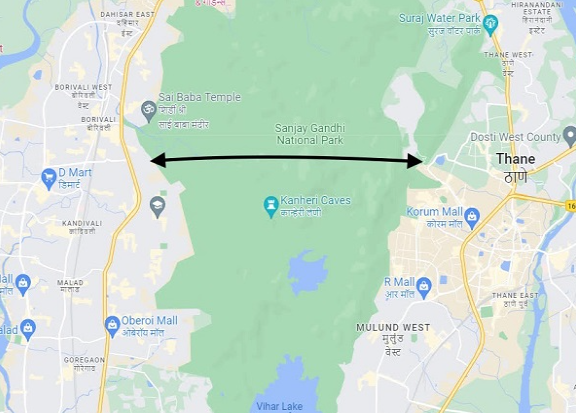India’s Longest Urban Tunnel Between Borivali and Thane (GS Paper 3, Growth & Development)

Introduction
- On July 13, 2024, Prime Minister Narendra Modi inaugurated the groundbreaking ceremony for the Thane-Borivali Twin Tunnel project in Mumbai.
- This ambitious Rs. 16,600 crore project is part of a larger Rs. 29,000 crore infrastructure development initiative aimed at significantly improving Mumbai's transportation network and connectivity.
Overview of the Thane-Borivali Twin Tunnel Project
- Project Cost: Rs. 16,600 crore.
- Length: 11.8 km.
- Connectivity: Direct subway line between Thane and Borivali, ending at Borivali on National Highway 8.
- Travel Time Reduction: From over an hour to just 12 minutes.
- Distance Reduction: 12 km.
- Lanes: Two regular lanes and one emergency lane.
- The Thane-Borivali Twin Tunnel project is designed to provide a seamless and rapid transit option between Thane and Borivali.
- By reducing the travel time from over an hour to just 12 minutes, the tunnel will greatly enhance the efficiency of commuting, offering a significant improvement in connectivity within Mumbai.
- The inclusion of two regular lanes and one emergency lane ensures that the tunnel can handle a substantial amount of traffic while providing a safe and reliable route for emergency situations.
-
Strategic Implications and Benefits
- The Thane-Borivali Twin Tunnel is not only a transportation link but also a strategic solution to alleviate traffic congestion on key routes such as Ghodbundar Road and the Western Express Highway.
- By offering a direct and rapid route, the tunnel aims to improve east-west suburban connectivity, streamline travel, and prevent road overcrowding.
Key Benefits:
- Traffic Decongestion: The tunnel will help reduce traffic on major roads, leading to smoother and faster travel.
- Economic Growth: Improved connectivity can boost economic activities by facilitating easier movement of goods and people.
- Enhanced Quality of Life: Reduced travel time and congestion will improve the daily commute for residents, enhancing their overall quality of life.
- Sustainability: By cutting down on travel time and distance, the tunnel will also contribute to reducing vehicle emissions, promoting environmental sustainability.
Environmental and Technical Details
- Environmental Impact: The project is designed to be environmentally friendly, with no impact on the adjacent Sanjay Gandhi National Park.
- Tunnel-Boring Machine: India’s longest tunnel-boring machine will be used, capable of boring a tunnel 10.25 km long with cross passages every 300 meters for safety and maintenance.
- Carbon Emission Reduction: The project is expected to reduce carbon emissions by 150,000 metric tons per year.
Environmental Considerations:
- The project emphasizes minimal environmental impact, particularly with regard to the Sanjay Gandhi National Park, a crucial green space in Mumbai.
- By using advanced technology and environmentally sustainable practices, the project aims to achieve its infrastructural goals without compromising the ecological balance.
Technical Advancements:
- The use of India’s longest tunnel-boring machine, capable of boring a tunnel 10.25 km long, demonstrates the project's commitment to leveraging cutting-edge technology.
- Cross passages every 300 meters will ensure safety and ease of maintenance, making the tunnel a robust and reliable infrastructure asset.
About Mumbai Metropolitan Region Development Authority (MMRDA)
- Established in 1975, the Mumbai Metropolitan Region Development Authority (MMRDA) is responsible for planning and overseeing development in the Mumbai Metropolitan Region. Key projects and achievements include:
- Bandra-Kurla Complex: A major business hub initiated by MMRDA.
- Mumbai's First Train (2014): MMRDA's milestone in urban transportation.
- Mumbai Metro: Overseen by MMRDA, with several lines under construction to ease traffic.
- Mumbai Urban Infrastructure Project: Managed by MMRDA to improve urban infrastructure.
- Mumbai Trans-Harbour Link: A project to facilitate travel between Mumbai and Navi Mumbai.
MMRDA's Role:
- The MMRDA has been instrumental in transforming Mumbai's urban landscape.
- From developing the Bandra-Kurla Complex, a prominent business district, to implementing the Mumbai Metro and the Mumbai Trans-Harbour Link, the MMRDA has consistently worked towards enhancing the city's infrastructure.
- The Thane-Borivali Twin Tunnel project is the latest in a series of initiatives aimed at making Mumbai a more accessible and livable city.
Future Prospects:
- As the Thane-Borivali Twin Tunnel project progresses, it is expected to serve as a model for similar infrastructure projects across India.
- The project's success will likely inspire further investments in urban infrastructure, driving economic growth and improving the quality of life for millions of residents.
- By prioritizing sustainability and leveraging advanced technology, India can continue to build resilient and efficient urban environments that meet the needs of its growing population.
Conclusion
- The Thane-Borivali Twin Tunnel project represents a significant leap forward in Mumbai's infrastructure development.
- By drastically reducing travel time and distance, and mitigating traffic congestion, the project is set to enhance urban mobility and contribute to environmental sustainability.
- The involvement of the Mumbai Metropolitan Region Development Authority (MMRDA) ensures that the project will be executed with a focus on efficiency, environmental care, and long-term urban planning.
- This project is a testament to India's commitment to modernizing its urban infrastructure and addressing the growing demands of its metropolitan regions.


